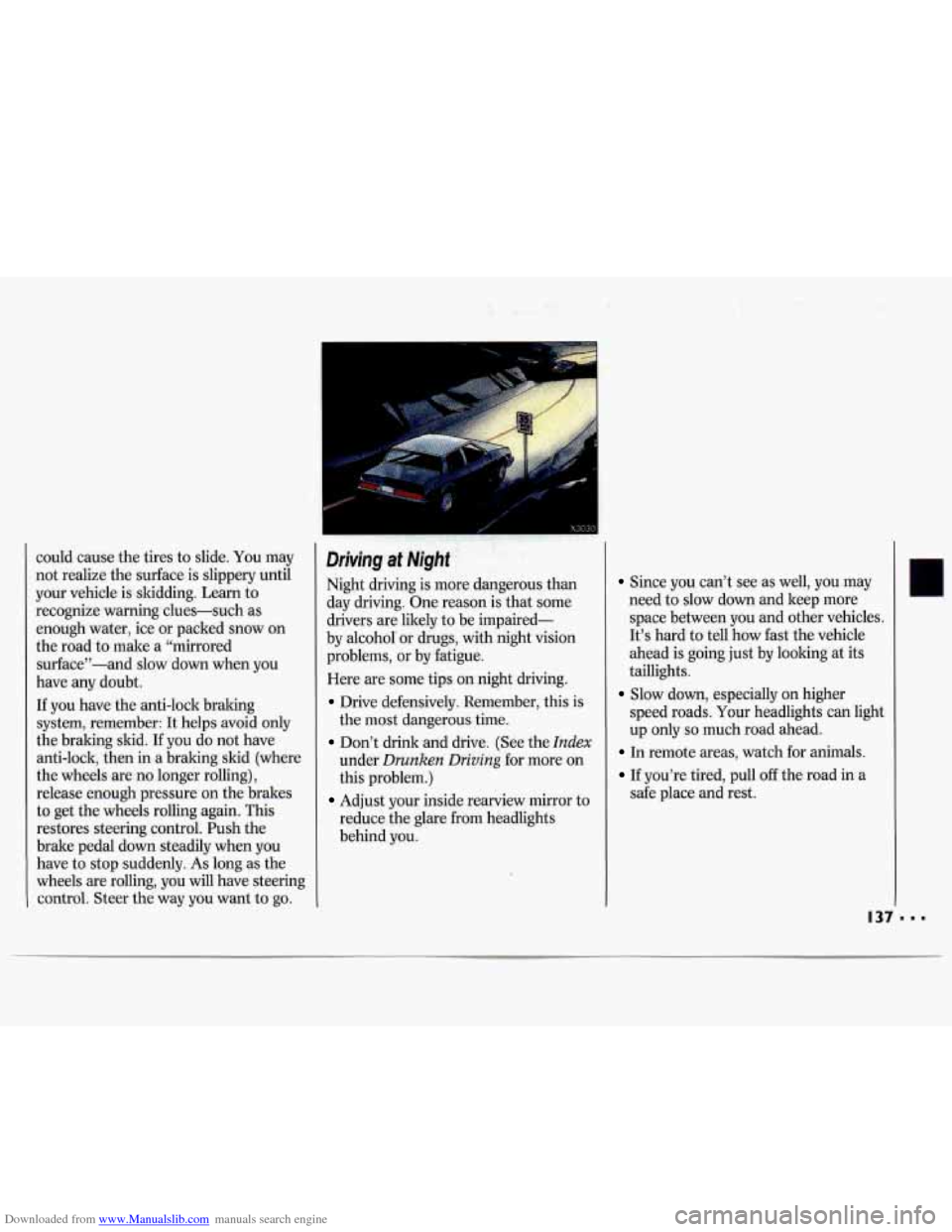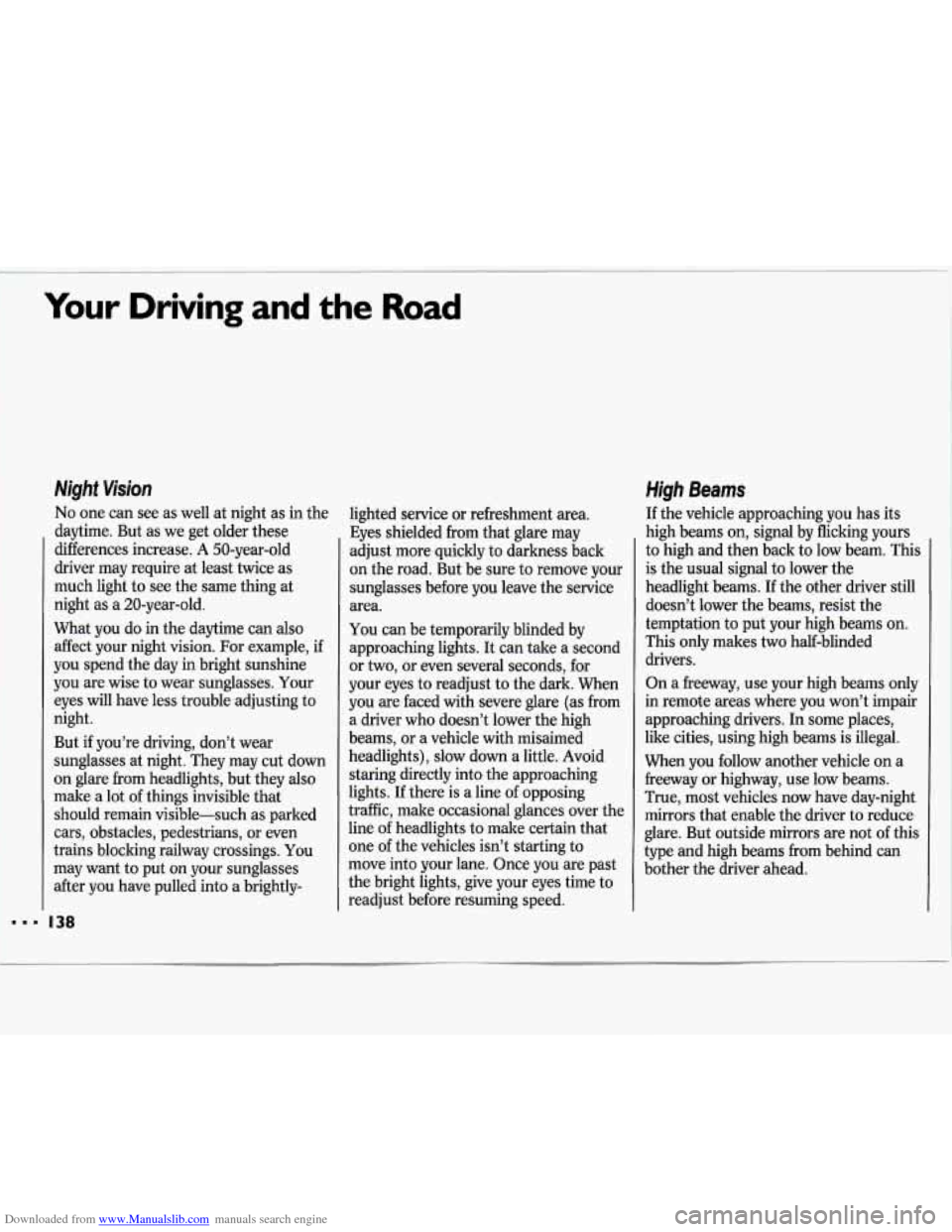1993 CHEVROLET LUMINA night vision
[x] Cancel search: night visionPage 139 of 324

Downloaded from www.Manualslib.com manuals search engine -.,.. -
could cause the tires to slide. You may
not realize the surface is slippery until
your vehicle is skidding. Learn to
recognize warning clues-such as
enough water, ice or packed snow on
the road to make a “mirrored
surface”-and slow down when you
have any doubt.
If you have the anti-lock braking
system, remember: It helps avoid only
the braking
skid. If you do not have
anti-lock, then
in a braking skid (where
the wheels are no longer rohg),
release enough pressure on the brakes
to get the wheels rolling again.
This
restores steering control. Push the
brake pedal down steadily when
you
have to stop suddenly. As long as the
wheels are rolling, you will have steering
control. Steer the way you want to
go.
-
X3030 , , -;. - ., ,
Driving. at Might
Night driving is more dangerous than
day driving. One reason is that some
drivers are likely to be impaired-
by alcohol or drugs, with night vision
problems,
or by fatigue.
Here are some tips on night driving.
Drive defensively. Remember, this is
the most dangerous time.
Don’t drink and drive. (See the Index
under Drunken Driving for more on
this problem.)
Adjust your inside rearview mirror to
reduce the glare from headlights
behind you.
Since you can’t see as well, you may
need to slow
down and keep more
space between you
and other vehicles.
It’s hard to tell how fast the vehicle
ahead’is going just by looking at its
taillights.
Slow down, esp.ecially on higher
speed roads. Your headlights can light
up only so much road ahead.
In remote areas, watch for animals.
If you’re tired, pull off the road in a
safe place and rest.
Page 140 of 324

Downloaded from www.Manualslib.com manuals search engine I
Your Driving and the Road
Night Vision
No one can see as well at night as in the
daytime. But as we get older these
differences increase.
A 50-year-old
driver may require at least twice as
much light to see the same thing at
night as a 20-year-old.
What you do in the daytime can also
affect your night vision. For example,
if
you spend the day in bright sunshine
you are wise to wear sunglasses. Your
eyes will have
less trouble adjusting to
night.
But
if you’re driving, don’t wear
sunglasses at night. They may cut down
on glare from headlights, but they also
make a lot
of things invisible that
should remain visible-such as parked
cars, obstacles, pedestrians, or even
trains blocking railway crossings.
You
may want to put on your sunglasses
after you have pulled into a brightly-
I38
lighted service or refreshment area.
Eyes shielded from that glare may
adjust more quickly to darkness back
on the road. But be sure to remove your
sunglasses before you leave the service
area.
You can be temporarily blinded by
approaching lights. It can tale a second
or two, or even several seconds, for
your eyes to readjust to the dark. When
you are faced with severe glare (as from
a driver who doesn’t lower the high
beams, or a vehicle with misaimed
headlights), slow down a little. Avoid
staring directly into the approaching
lights. If there is a line
of opposing
traffic, make occasional glances over the
line of headlights to make certain that
one of the vehicles isn’t starting to
move into your lane. Once you are past
the bright lights, give your eyes time to
readjust before resuming speed.
High Beams
If the vehicle approaching you has its
high beams on, signal by flicking yours
to high and then back to low beam. This
is the usual signal to lower the
headlight beams. If the other driver still
doesn’t lower the beams, resist the
temptation to put your high beams on.
This
only makes two half-blinded
drivers.
On a freeway, use your high beams only
in remote areas where you won’t impair
approaching drivers.
In some places,
like cities, using high beams is illegal.
When you follow another vehicle on a
freeway or highway, use low beams.
True, most vehicles now have day-night
mirrors that enable the driver to reduce
glare. But outside mirrors are not
of this
type and high beams from behind can
bother the driver ahead.
Page 149 of 324

Downloaded from www.Manualslib.com manuals search engine On the Road
Unless you are the only driver, it is good
to share the driving task with others.
Limit turns behind the wheel to about
100 miles (160 km) or two hours at a
sitting. Then, either change drivers or
stop for some refreshment like coffee,
tea or soft drinlts and some limbering
up. But do stop and move around. Eat
lightly along the way. Heavier meals
tend to make some people sleepy.
On two-lane highways or undivided
multilane highways that do not have
controlled access, you’ll want to watch
for some situations not usually found
on freeways. Examples are: stop signs
and signals, shopping centers with
direct access to the highway, no passing
zones and school zones, vehicles
turning left and right off the road,
pedestrians, cyclists, parked vehicles, and even animals.
Highway Hypnosis
Is there actually such a condition as
“highway hypnosis”? Or is it just plain
falling asleep at the wheel? Call it
highway hypnosis, lack of awareness, or
whatever.
There is something about an easy
stretch of road with the same scenery,
along with the hum of the tires on the
road, the drone of the engine, and the
rush of the wind against the vehicle that
can make you sleepy. Don’t let it
happen to you! If it does, your vehicle
can leave the road in
less than a second,
and you could crash and be injured.
What can you do about highway
hypnosis? First, be aware that it can
happen.
Then here are some tips:
Make sure your vehicle is well
ventilated, with a comfortably cool interior.
Keep your eyes moving. Scan the road
ahead and to the sides. Check your
rearview mirrors frequently and your
instruments from time to time. This
can help you avoid a fixed stare.
Wear good sunglasses in bright light.
Glare can cause drowsiness. But don’t
wear sunglasses at night. They will
drastically reduce your overall vision
at the very time you need all the
seeing power you have.
If you get sleepy, pull off the road into
a rest, service, or parking area and
take a nap, get some exercise, or both.
For safety, treat drowsiness on the
highway as an emergency.
As in any driving situation, keep pace
with traffic and allow adequate
following distances.